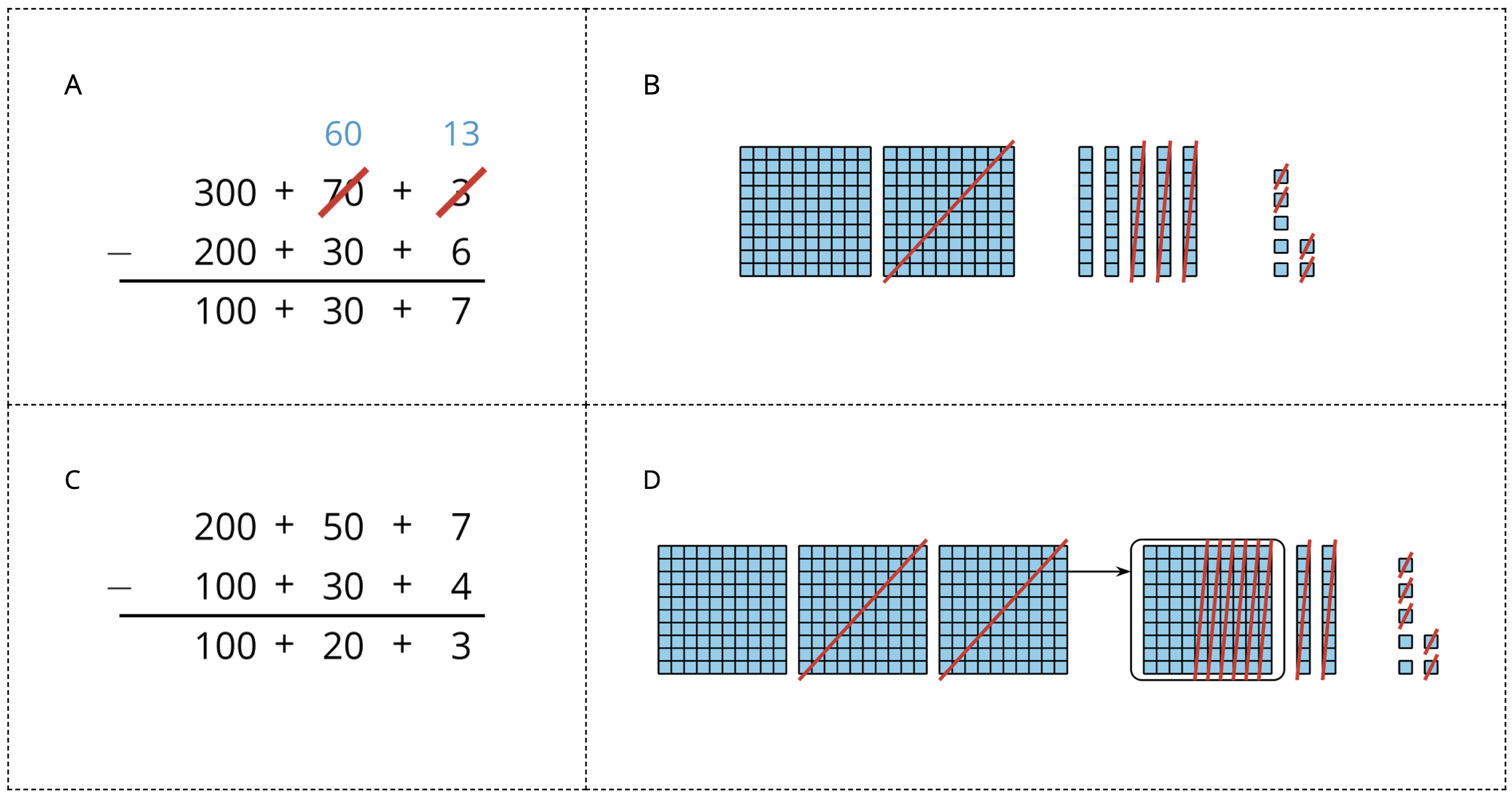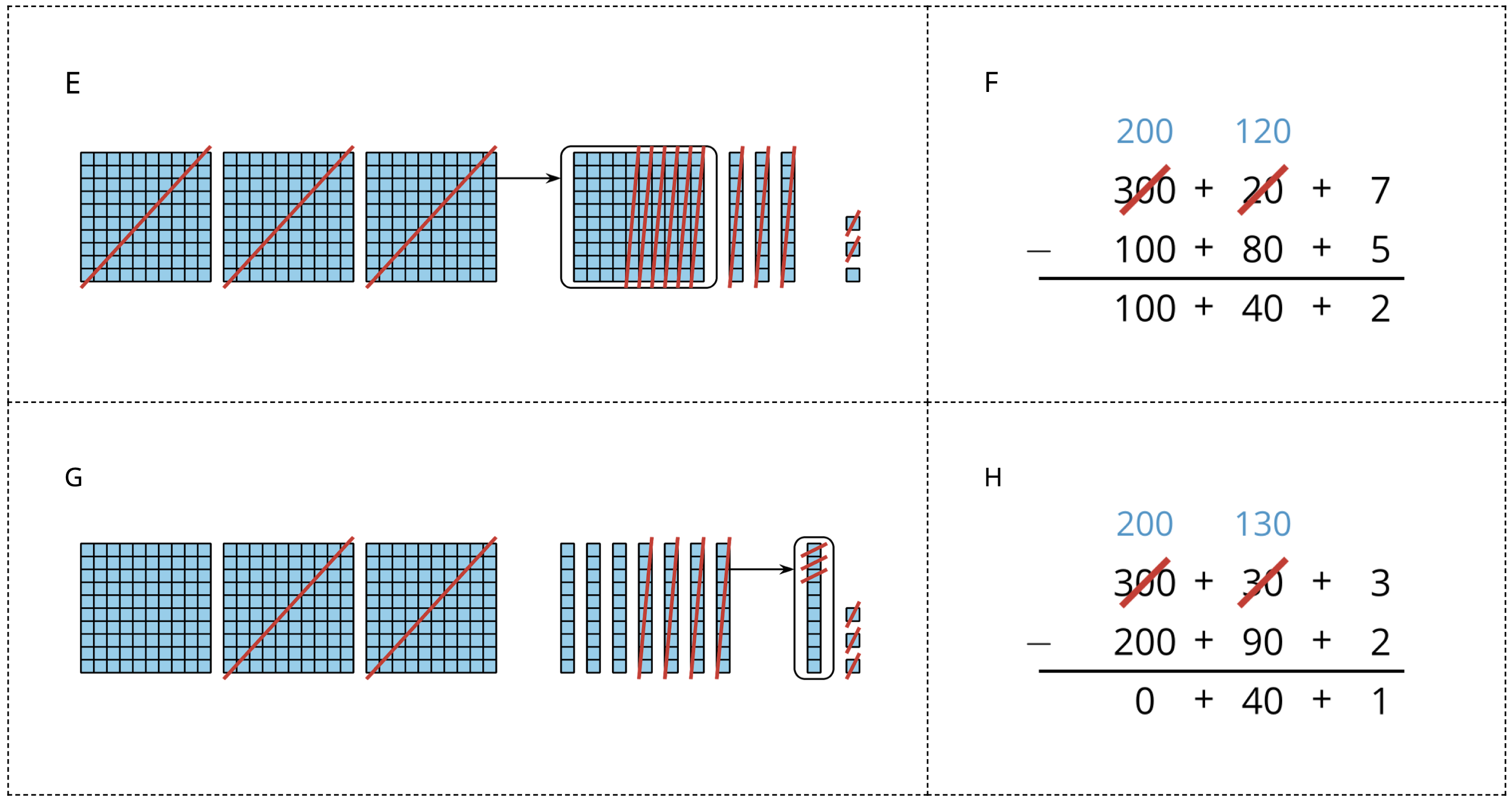Lesson 8
Subtraction Algorithms (Part 1)
Warm-up: Number Talk: Subtraction Strategies (10 minutes)
Narrative
The purpose of this Number Talk is to elicit strategies students have for subtracting within 1,000. These understandings help students develop fluency and will be helpful later when students choose between using an algorithm or another strategy to subtract.
Launch
- Display one expression.
- “Give me a signal when you have an answer and can explain how you got it.”
- 1 minute: quiet think time
Activity
- Record answers and strategy.
- Keep expressions and work displayed.
- Repeat with each expression.
Student Facing
Find the value of each expression mentally.
- \(100 - 98\)
- \(101 - 99\)
- \(200 - 98\)
- \(204 - 98\)
Student Response
For access, consult one of our IM Certified Partners.
Activity Synthesis
- “How did the first couple of expressions help you find the value of later expressions?” (When I noticed that the numbers had adjusted a little, it was easy to adjust the difference the same way. Sometimes it looked like a new problem, but both of the numbers had gone up the same amount so the difference was the same.)
- Consider asking:
- “Who can restate _____'s reasoning in a different way?”
- “Did anyone have the same strategy but would explain it differently?”
- “Did anyone approach the problem in a different way?”
- “Does anyone want to add on to _____’s strategy?”
Activity 1: From Drawings to an Algorithm (15 minutes)
Narrative
The purpose of this activity is for students to use their knowledge of base-ten diagrams and place value to make sense of a subtraction algorithm. Students notice that in both the base-ten drawing and the algorithm, the subtraction happens by place. We can find the difference of two numbers by subtracting ones from ones, tens from tens, and hundreds from hundreds, and adding these partial differences to find the overall difference.
Students also recall that sometimes a place value unit needs to be decomposed before subtracting. For example, a ten may first need to be decomposed into 10 ones. This decomposition can be seen in both the base-ten drawing and in the algorithm. In the synthesis, students interpret the work and reasoning of others (MP3).
Launch
- Groups of 2
- Display Jada’s drawing.
- “Jada and Kiran found the value of \(391-215\). Take a minute to make sense of Jada’s drawing.”
- 1–2 minutes: quiet think time
- Share responses.
Activity
- “Work with your partner to make sense of Kiran’s algorithm and complete the questions about his work.”
- 5-7 minutes: partner work time
Student Facing
Jada and Kiran found the value of \(391-215\). Their work is shown.
Jada’s drawing

Kiran’s algorithm

- Explain how Kiran’s algorithm starts.
- Explain how Kiran recorded the decomposition of the ten into more ones.
- Finish Kiran’s work.
Student Response
For access, consult one of our IM Certified Partners.
Advancing Student Thinking
If students don't explain the written algorithm, consider asking:
- “How did each student subtract?“
- “How could Jada's drawing help us understand Kiran's work?“
Activity Synthesis
- Invite students to share their responses.
- “How did Kiran know to rewrite 391?” (If he tried to subtract the ones, he would notice he doesn’t have enough, so he needs to decompose a ten into 10 ones.)
- “Why is he allowed to rewrite \(300 + 90 + 1\) as \(300 + 80 + 11\)?” (Both of these add up to 391. They’re both showing 391 in different ways.)
- “How is Kiran's reasoning like Jada's reasoning?” (Both of them decomposed the numbers into hundreds, tens, and ones, and subtracted the numbers in each place separately. Both of them decomposed a ten into 10 ones.)
- “How is their reasoning different?” (Jada used base-ten drawings to represent the numbers and Kiran wrote them out in expanded form.)
- “How did you finish Kiran’s work?” (I subtracted the ones, the tens, and then the hundreds. I subtracted the hundreds, the tens, and then the ones.)
- Record Kiran’s completed algorithm and keep it posted throughout this lesson and the following lesson.
Activity 2: Card Sort: Diagrams and Algorithms (20 minutes)
Narrative
The purpose of this activity is for students to analyze the connections between algorithms and base-ten diagrams that represent subtraction. In particular, students relate how the two strategies show a hundred decomposed into tens and a ten into ones in order to facilitate subtraction.
As students work, encourage them to refine their descriptions of what is happening in both the diagrams and the algorithms using more precise language and mathematical terms (MP6).
Advances: Listening, Speaking, Representing
Supports accessibility for: Organization, Social-Emotional Functioning
Required Materials
Materials to Copy
- Diagrams and Algorithms
Required Preparation
- Create a set of cards from the blackline master for each group of 2.
Launch
- Groups of 2
- Distribute one set of pre-cut cards to each group of students.
Activity
- “This set of cards includes base-ten diagrams and algorithms that represent the same subtraction. Match each diagram to an algorithm. Work with your partner to explain your choices.”
- 8 minutes: partner work time
Student Facing
Your teacher will give you a set of cards. Match each diagram with an algorithm.


Student Response
For access, consult one of our IM Certified Partners.
Activity Synthesis
- Select 2–3 students to share a match they made and how they know the cards go together.
- “In the diagrams, why were the hundreds sometimes moved over into the tens place?” (This happened when there weren’t enough tens to subtract. We used a hundred to get more tens.)
- “How was this shown in the algorithm?” (A hundred was crossed out and 10 more tens were added to the tens place, like in F, 20 was crossed out and 120 was written above it.)
Lesson Synthesis
Lesson Synthesis
Display a completed algorithm for addition that uses expanded form and a completed algorithm for subtraction that uses expanded form, such as:


“Today we learned an algorithm for subtraction. How is this algorithm similar to the algorithm we used for addition? How is it different?” (Both of the algorithms use expanded form. With both of them, you have to compose the parts of the number at the end to get the answer. In the addition algorithm, there’s a ten being composed, but in the subtraction algorithm, it’s being decomposed to get more ones. The new ten is recorded below in the addition algorithm, but when you decompose a ten for subtracting, it’s recorded above the numbers.)
Cool-down: Connect a Diagram and an Algorithm (5 minutes)
Cool-Down
For access, consult one of our IM Certified Partners.